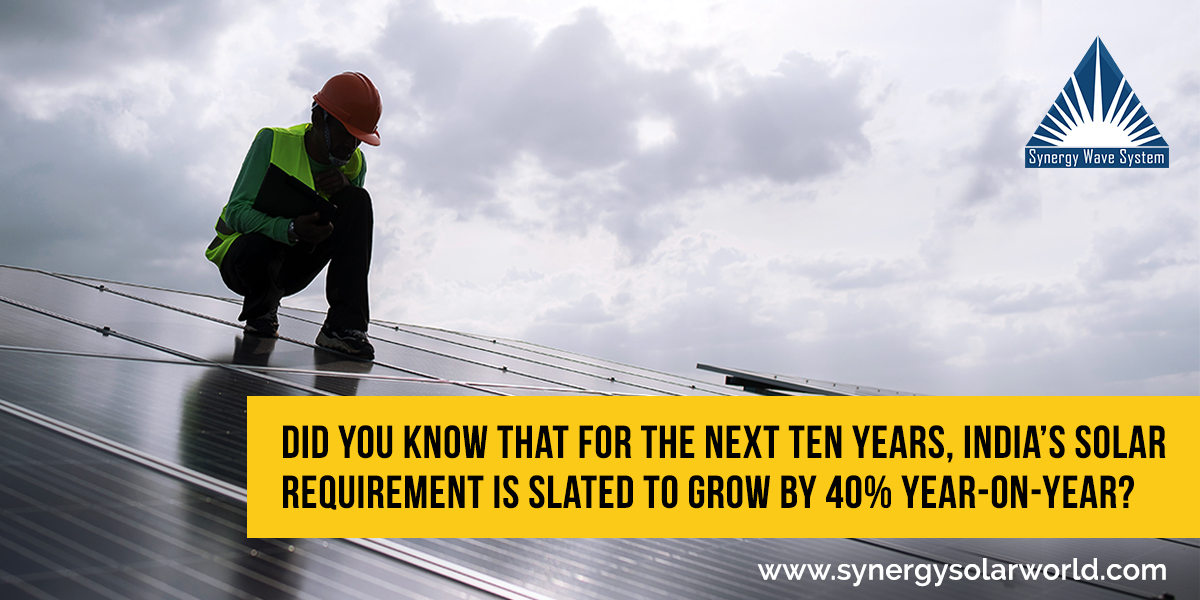Synergy Wave System

Indian Supply Chain for the Solar Energy Sector
Indian Supply Chain for the Solar Energy Sector
Self-sufficiency in energy is crucial for any country when it comes to socio-economic development. India’s rapid industrialization and modernization has fuelled economic growth, which has put tremendous pressure on the nation’s energy demand. Solar is the preferred option, for its virtually limitless supply, and its highest band of average annual solar energy globally. But where is India headed when it comes to drawing up and implementing a robust supply chain for such an aggressive vision? Let’s try and answer that question.
Government of India set up Jawaharlal Nehru National Solar Mission (JNNSM) with a key objective of setting up and sustaining a strong manufacturing base for solar energy in India. Coupled with high employment generation and relatively low costs for manufacturing, this is supposedly of strategic nature, also because the National Manufacturing Policy identifies solar energy sector with strategic significance, along with Defence, Aerospace and Telecom.
Solar energy demand and supply are of primarily two categories, photovoltaic and thermal. Although, in the last few years, the demand for both photovoltaic and thermal has seen a staggering rise in the country (mainly thanks to numerous central and state-backed initiatives), Indian manufacturers are facing stiff competition from foreign suppliers due to lower interest costs, overcapacity and far better subsidies as compared to India. China, for example, has managed to capture 60-70 per cent of the global solar market because of favourable policies offered by its government.
Key Issues in Solar Supply Chain
The backbone of any solid supply chain lies in not only a cost effective supply of raw materials but also in increasing the efficiency of the production process and rationalizing raw material inventory. The Indian manufacturing of solar modules has been by-and-large dependent on foreign imports of critical raw materials. On the other hand, finished products are primarily exported to developed western markets. There is tremendous scope in optimizing the supply chain to make the Indian manufacturers run on optimal levels of efficiency and cost effectiveness. Other than raw material supply, other issues that are being faced are technology sourcing and development, proper manufacturing knowhow, skilled manpower, ongoing investment in R&D, and implementation of global industry standards.
Benchmarking the Supply Chain
For the next 10 years, India’s solar requirement is slated to grow by 40 per cent year-on-year. This will put added pressure on the existing value chain for calling for better efficiency. However, if planned and executed in a thought-out way, India can become one of the most competitive solar manufacturers and exporters in the world. Indian solar industry standards, if benchmarked against their global counterparts, show a massive gap in where we must be in order to compete globally. Total project cost in India is higher by 15-20 per cent as compared to their Chinese and other Asian counterparts because of factors like acquisition of land and infrastructure cost being higher in India. On the contrary, Chinese government allots land for solar projects at subsidized rates with infrastructure costs included. Project loans are at nearly 15 per cent interest rate, with shorter duration, as opposed to China and US companies offering loans at 0-5 per cent with longer loan tenures. Raw material cost in India is higher as mostly all components are imported. While China and other Asian countries tend to keep this cost low as raw material is locally manufactured. Add to this India’s virtually zero export-import benefits and poor infrastructure of logistics and we have high costs of capital and no support-ecosystem.
Securing a Robust Supply Chain
An optimal supply chain is the need of the hour for a bright future of the renewable energy sector in India. And this squarely rests on a low-cost yet efficient manufacturing base. A structured approach will make Indian manufacturing units competitive domestically as well as globally. Additionally, while the capacity of solar plants in India is growing, they are a long shot from being compared to multi-Gw capacity plants around the world. This greatly compromises India’s position to bargain for sourcing and marketing. On the contrary, in increased capacity plants, we can look at optimized capital costs, better turnover and efficiency.
India has the potential to become the solar capital of the world. However, there needs to be a structured, multi-level approach in becoming so. Government support will play a crucial role in getting India to where it can be. Lower taxes, lower cost financing, increased subsidies, priority sector lending are all going to play key factors in the next few years.
